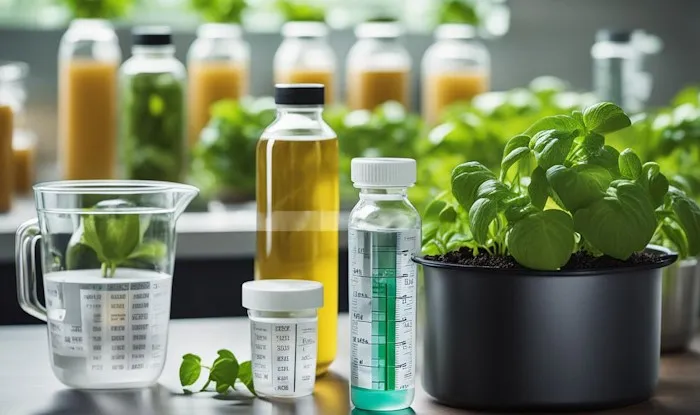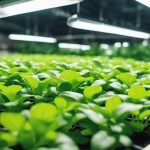Mixing nutrients for hydroponics is a vital step in ensuring that your plants receive the optimal blend of minerals and vitamins they need to thrive. In hydroponic systems, where soil is replaced by water, delivering the right nutrients directly to plant roots is crucial. You have the ability to fine-tune the nutrients to meet the specific requirements of your plants at various stages of their growth cycle. Knowing the basics, such as the significance of N-P-K (nitrogen, phosphorus, potassium) mix, calcium nitrate, and magnesium sulfate (Epsom salt), can establish a foundation for healthy plant development.

As you prepare to mix your hydroponic nutrients, consider the quality of your water, since it’s the carrier of your nutrient solution. If you’re starting with hard water, which contains minerals that could affect the nutrient balance, you might need to purify it using methods like reverse osmosis. This ensures that the nutrients you add are the ones your plants will actually consume. Additionally, mixing nutrients requires precision and attention to detail – the order in which you mix them and the pH level of the solution can have significant impacts on nutrient availability.
Understanding the role of both macro and micronutrients is essential because your plants will need them in different quantities. Macronutrients like nitrogen, potassium, and phosphorus are needed in larger amounts, while micronutrients such as iron, manganese, and zinc are required in smaller quantities but are just as crucial for plant health. By grasping these concepts, you lay the groundwork for lush growth and bountiful yields in your hydroponic garden.
What You’ll Need for Mixing Hydroponic Nutrients
To start mixing nutrients for your hydroponic system, you’ll need several items to ensure your plants receive the correct nourishment. Here’s a friendly guide to what you should have on hand:
- Measuring Equipment: Accurate measurements are crucial. You’ll need a set of measuring spoons or cups along with a liquid measuring device, like a graduated cylinder or syringe, to measure out your nutrients.
- Nutrient Solutions: Purchase a hydroponic nutrient solution that’s suitable for the type of plants you’re growing. Commonly, these solutions come in a two or three-part system that you’ll mix with water. Macronutrients are for primary growth needs: N (Nitrogen), P (Phosphorus), K (Potassium). Micronutrients are for plant processes: Iron (Fe), Manganese (Mn), Boron (B), etc. Learn more about water nutrients for hydroponics here.
- pH Testing and Adjustment Kit: Your plants will only be able to absorb nutrients effectively if the pH level is within the correct range. Test strips or a digital pH meter will be needed, along with pH up or down solutions.
- EC or TDS Meter: To monitor the strength of your nutrient solution, an Electrical Conductivity (EC) or Total Dissolved Solids (TDS) meter is essential.
- Water Source: Clean water is the base of your nutrient solution. Make sure it’s filtered or purified to avoid any unwanted elements.
- Mixing Container: You’ll need a reservoir or container for mixing and holding your nutrient solution. A large bucket or storage tote can work well.
- Stirring Tool: Use a stirrer or pump to evenly mix the nutrients into the water, ensuring they’re well-dissolved.
Creating the Perfect Mix
To thrive, your hydroponic plants need the right balance of nutrients. Here’s how you can create the optimal nutrient mix for healthy plant growth.
Selecting Base Nutrients and Additives
Your journey begins with choosing the right base nutrients and additives. Base nutrients typically consist of a balanced N-P-K mix (nitrogen, phosphorus, potassium) and are essential for basic plant growth. However, hydroponic plants also require adequate micronutrients such as calcium, magnesium, and sulfur, as well as trace elements like iron, manganese, zinc, copper, boron, and molybdenum. These can be sourced from various fertilizers and supplements, for instance, calcium nitrate or Epsom salt for magnesium. Remember, each plant has unique requirements, so cater to those specific nutrient ratios for best results.
Nutrient Mixing Order
If you’re a beginner in hydroponic growing, it’s advisable to start with a straightforward 2 or 3-part nutrient kit that includes only a handful of vital supplements. When it comes to nutrient mixing order, precision is key. Begin by mixing silica into the purified water. Silica is incorporated to fortify plant cell walls. It should be added first because it would otherwise bond with the other elements, rendering them unavailable to the plants. Wait for several minutes to allow the silica to bond with the water molecules, and then add your base nutrient mix to the water, ensuring it’s fully dissolved before introducing any additives.
Add micronutrients one at a time, carefully following the manufacturer’s instructions to avoid nutrient lockout, where plants are unable to absorb certain nutrients due to an imbalance. Calcium and magnesium often go in first, followed by micronutrients like iron and copper, then any growth enhancers. This structured approach ensures each nutrient is properly assimilated into the mix.

How to Mix Hydroponic Nutrients: Step-by-Step
Now, let’s walk through the step-by-step process of mixing hydroponic nutrients:
- Fill Your Reservoir: Start with clean, filtered water to avoid contamination and mineral imbalances.
- Measure Your Nutrients: Carefully follow the nutrient ratios recommended for your plants. Utilize measuring cups or scales for accuracy.
- Add silica: Add your silica supplement to the water, mix, and let it sit for at least 10 minutes but preferably for 20 minutes.
- Mix Base Nutrients: Slowly add your base nutrients to the silica-enriched water, stirring continuously until fully dissolved. Usually, the first is the B-part nutrient, which is the phosphate.
- Optionally add cal-mag: If you’re using RO water, then all minerals would have been stripped out of it. However, calcium and magnesium are important, so add this if necessary.
- Add Micronutrients and other additives: Introduce micronutrients individually, thoroughly mixing each before adding the next. Then add any growth enhancers, boosters, enzymes or vitamins that are especially helpful to the specific plant and its current growth phase.
- pH and EC Testing: Adjust the pH level to suit your specific crop needs, typically between 5.5 to 6.5. Also, check the Electrical Conductivity (EC) to ensure appropriate nutrient strength.
- Final Adjustments: Re-test and adjust pH and EC if necessary, and then allow the solution to settle before introducing to your plants.
Following these guidelines will help you mix a nutrient solution that promotes strong, healthy plant development in your hydroponic system.
Related: How long do hydroponic nutrients last? Find out now!
Optimizing Hydroponic Systems
In a hydroponic system, precise control over your nutrient mix and environment can lead to healthier plants and increased yields. Let’s explore how to achieve this balance through proper pH management, maintaining the nutrient reservoir, and adjusting for plant growth and health.
The Role of pH Levels in Nutrient Uptake
For your plants to thrive, the pH level of your nutrient solution should be closely monitored. Most crops absorb nutrients efficiently when the pH is between 5.5 and 6.5. Outside this range, certain nutrients become less available, which can hinder plant growth and affect chlorophyll production. Use a reliable pH meter to test your solution regularly and make adjustments using pH up or down agents.
Maintaining the Nutrient Reservoir
Your nutrient reservoir acts as the heart of your hydroponic garden, so its health is crucial. Start with clean, filtered tap water to avoid unwanted minerals that can unbalance your mix. Replenish the reservoir with base nutrients and follow the manufacturer’s label for correct dosing. Keep an eye on water levels in your container or sump; they can fluctuate due to evaporation and plant uptake. A stable reservoir with adequate macronutrients and micronutrients supports optimal nutrient uptake.
Adjusting to Plant Growth and Health
As your plants grow, their nutrient demands can change. It’s vital to adjust the nutrient solution to match different growth stages for maximum health and production. Immature plants typically require a higher mix of nitrogen fertilizer for hydroponics to support foliage development, while flowering crops need increased phosphorus and potassium. Set a consistent feeding schedule and be prepared to replenish your reservoir with fresh nutrients periodically to support your plant’s health and maximize yields in your hydroponic system.
Related: If you notice nutrient burn on leaves, it means that you are overfeeding your plant and should course correct.
Frequently Asked Questions
Navigating the world of hydroponic nutrients can be complex. Here, you’ll find answers to some common questions that can help you achieve a successful hydroponic garden.






